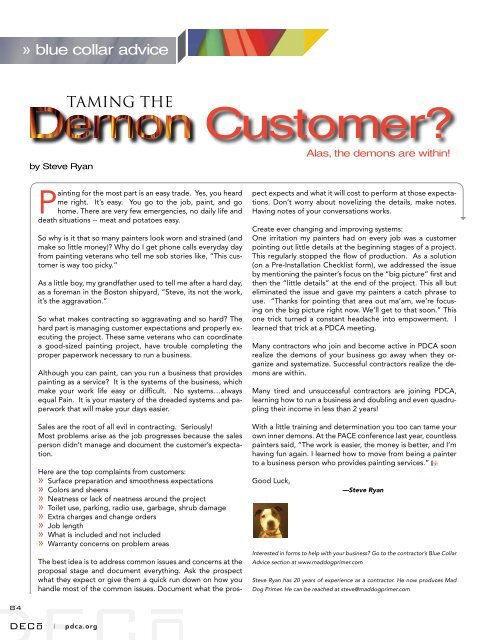n o v/d e c • 2 0 0 8 - Subscribe
n o v/d e c • 2 0 0 8 - Subscribe
n o v/d e c • 2 0 0 8 - Subscribe
You also want an ePaper? Increase the reach of your titles
YUMPU automatically turns print PDFs into web optimized ePapers that Google loves.
84<br />
» blue collar advice<br />
Taming the<br />
Demon Customer?<br />
Alas, the demons are within!<br />
by Steve Ryan<br />
Painting for the most part is an easy trade. Yes, you heard<br />
me right. It’s easy. You go to the job, paint, and go<br />
home. There are very few emergencies, no daily life and<br />
death situations -- meat and potatoes easy.<br />
So why is it that so many painters look worn and strained (and<br />
make so little money)? Why do I get phone calls everyday day<br />
from painting veterans who tell me sob stories like, “This customer<br />
is way too picky.”<br />
As a little boy, my grandfather used to tell me after a hard day,<br />
as a foreman in the Boston shipyard, “Steve, its not the work,<br />
it’s the aggravation.”<br />
So what makes contracting so aggravating and so hard? The<br />
hard part is managing customer expectations and properly executing<br />
the project. These same veterans who can coordinate<br />
a good-sized painting project, have trouble completing the<br />
proper paperwork necessary to run a business.<br />
Although you can paint, can you run a business that provides<br />
painting as a service? It is the systems of the business, which<br />
make your work life easy or difficult. No systems…always<br />
equal Pain. It is your mastery of the dreaded systems and paperwork<br />
that will make your days easier.<br />
Sales are the root of all evil in contracting. Seriously!<br />
Most problems arise as the job progresses because the sales<br />
person didn’t manage and document the customer’s expectation.<br />
Here are the top complaints from customers:<br />
» Surface preparation and smoothness expectations<br />
» Colors and sheens<br />
» Neatness or lack of neatness around the project<br />
» Toilet use, parking, radio use, garbage, shrub damage<br />
» Extra charges and change orders<br />
» Job length<br />
» What is included and not included<br />
» Warranty concerns on problem areas<br />
The best idea is to address common issues and concerns at the<br />
proposal stage and document everything. Ask the prospect<br />
what they expect or give them a quick run down on how you<br />
handle most of the common issues. Document what the pros-<br />
| pdca.org<br />
pect expects and what it will cost to perform at those expectations.<br />
Don’t worry about novelizing the details, make notes.<br />
Having notes of your conversations works.<br />
Create ever changing and improving systems:<br />
One irritation my painters had on every job was a customer<br />
pointing out little details at the beginning stages of a project.<br />
This regularly stopped the flow of production. As a solution<br />
(on a Pre-Installation Checklist form), we addressed the issue<br />
by mentioning the painter’s focus on the “big picture” first and<br />
then the “little details” at the end of the project. This all but<br />
eliminated the issue and gave my painters a catch phrase to<br />
use. “Thanks for pointing that area out ma’am, we’re focusing<br />
on the big picture right now. We’ll get to that soon.” This<br />
one trick turned a constant headache into empowerment. I<br />
learned that trick at a PDCA meeting.<br />
Many contractors who join and become active in PDCA soon<br />
realize the demons of your business go away when they organize<br />
and systematize. Successful contractors realize the demons<br />
are within.<br />
Many tired and unsuccessful contractors are joining PDCA,<br />
learning how to run a business and doubling and even quadrupling<br />
their income in less than 2 years!<br />
With a little training and determination you too can tame your<br />
own inner demons. At the PACE conference last year, countless<br />
painters said, “The work is easier, the money is better, and I’m<br />
having fun again. I learned how to move from being a painter<br />
to a business person who provides painting services.”<br />
Good Luck,<br />
—Steve Ryan<br />
Interested in forms to help with your business? Go to the contractor’s Blue Collar<br />
Advice section at www.maddogprimer.com<br />
Steve Ryan has 20 years of experience as a contractor. He now produces Mad<br />
Dog Primer. He can be reached at steve@maddogprimer.com








